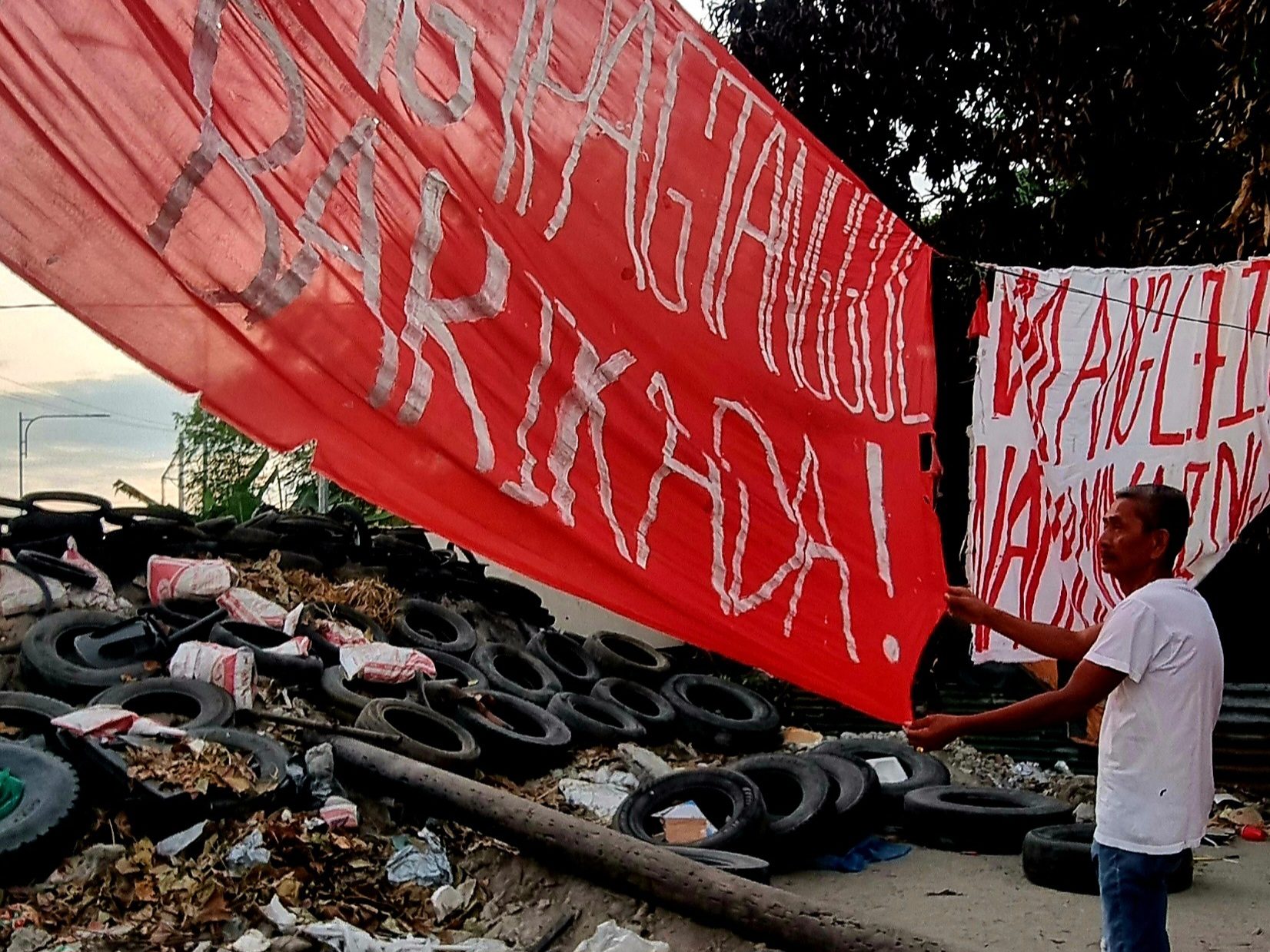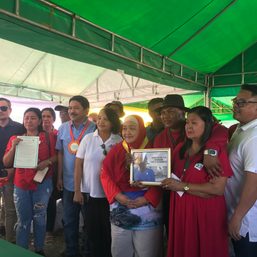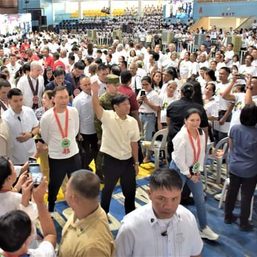SUMMARY
This is AI generated summarization, which may have errors. For context, always refer to the full article.

ANGELES CITY, Philippines – After four bloody demolitions in the last six months, the latest happening in March, more than 500 families were forced to flee the land where they had lived all their lives in Barangay Anunas here.
The 2,000 residents of Sitio Balubad have been fighting Clarkhills Properties Corporation, which had laid claim on the 73-hectare land whose parcels were awarded to the families by the Department of Agrarian Reform (DAR) in Quezon City in 1998 and 1999 during the presidencies of Fidel Ramos and Joseph Estrada.
Angeles City Mayor Carmelo Lazatin Jr. has been given authority by the city council to expropriate of 3.5 hectares of the disputed land, so the 535 families can own them through the local government’s socialized housing project. The remaining 70 hectares would go to Clarkhills.
The holders of Certificates of Land Ownership Award (CLOA) wouldn’t have any of this. The 73 hectares are theirs, they say, and they are calling for a reinvestigation into how Clarkhills gained a claim on the agricultural land awarded to the families.

Series of demolitions
“We are the legitimate owners of this property. We are not illegal settlers. We are fighting for our right as legal owners. We just want this to be reinvestigated. We are not illiterate. We know what’s going on. We know our rights,” said Joy (not her real name) days before the March 12 demolition.
Joy is one of the 74 CLOA holders of a five-hectare land within the area. She showed Rappler a copy of a certification from the City Planning and Development Office (CPDO), which states that the disputed land is within an agricultural zone, per an ordinance issued in August 1978 – or 46 years ago.
The 535 families remain standing despite the series of violent demolitions that led to their exodus since September 2023, which stemmed from a re-implementation order from the Department of Agrarian Reform Adjudication Board (DARAB).
The demolished properties included residential houses, a commercial laundry warehouse, and a furniture factory. Some of the structures were destroyed by the owners themselves for fear of what else the demolition team would do as they came closer to their homes.
Land classification and expropriation
Clarkhills’ former legal counsel Gener Endona said that one of the reasons for the cancellation of the CLOAs was the re-classification of the 73 hectare as “residential land.”
In August 2020, Endona submitted to the Registry of Deeds (RD) documents that would support the request to cancel the CLOAs: Certificate of Finality, Supreme Court order, DARAB order, and Entry of Judgment.
In a letter to Lazatin last February 9, Endona mentioned that occupants of the property had constructed commercial buildings in the area, rental staycations with swimming pools, and apartment units. Some of the tenants had sold the land to third persons.
Endona said they had been requesting the names of the indigent households and the original tenants and their children who occupy the lot and have not sold any portion of the land to third persons. They were going to submit these to the Department of Human Settlement and Urban Development (DHSUD) for its Pambansang Pabahay Para sa Pilipino (4PH) program.
The project would entail the construction of a four-story residential building, with 20 units per floor at 27-square meter per unit.
Amid the violent demolitions, Mayor Lazatin said the local government unit would cease negotiations with Clarkhills and proceed with the expropriation of 3.5 hectares for its housing project.
“We will ensure that we will acquire the concerned property in favor of our constituents,” Lazatin said in his letter to Oscar Torralba, president of Clarkhills Properties Corporation, cited in a press release.
“Considering the present circumstances and this impasse in the communication between the city government and Clarkhills, we believe that the best course of action for us is to proceed with the expropriation,” Lazatin added.
Although the decision to expropriate lies with the Angeles City trial court once the mayor files the case, Joy said it is still a step they will welcome towards reinvestigation.

“We are holding on to our right as the legal owners of this property. That is where we are drawing our strength, why we are not going anywhere, especially those who are just like me, who were born here, grew up here. Our ancestors, our parents, passed this down to us,” said Joy.
“For us, it is not just about the ownership but also the memories we have here that we can pass down to our kids. But even that is being taken away from us.”
An agricultural zone
Barangay Anunas is among the four remaining agricultural zones identified by the CPDO of Angeles. The other ones are in barangays Cuayan, Cutud, and Mining.
Based on the City Land Use Plan, highly urbanized cities such as Angeles are allowed to reclassify 15% of their remaining agricultural zones. The CLUP also states that the land requirements should not come from the remaining agricultural lands as there are still vacant or idle lands in the present built-up areas that can accommodate expansion.
Arnel San Pedro, head of the City Information Office, confirmed to Rappler on February 24, that there was never a permit that allowed the reclassification of the contested land in Sitio Balubad. No request was made to the city council to reclassify the land, he said.
San Pedro said the local government may no longer reclassify the remaining agricultural lands in Angeles City. He added that the reclassification of lands would require public hearings and approval by the city council.
“The land ceases to be economically feasible and sound for agricultural purposes. It should also have a greater economic value for residential, commercial, or industrial purposes,” San Pedro said.
“Under the spatial strategy of the CLUP, full urbanization does not happen overnight. Thus, the area’s existing agricultural lands will be protected from irrational conversion, land banking, and speculation, and the same will be devoted to food and high value crop production until such time that their highest and best uses are no longer agriculture,” he added.
Based on the 2010-2020 zoning map of Angeles City, the agricultural zone or tropical grass comprise 483 hectares out of 1,200 hectares of production areas.
The CLOA holders have paid their lots in full when they received a letter from LandBank of the Philippines to settle their due balance from 2017 to 2019.
LandBank’s agrarian services administrative unit head Rossano Cruz told Rappler in an interview on February 12 that even if the farmers had paid their lots in full, a refund would still be possible, depending on the situation of the agrarian reform beneficiaries.
Cruz said they would still follow the policies of the DAR whether the farmer is qualified for a refund. The amount, he said, would be the same as what they had paid.
Pattern of reversal
Senator Risa Hontiveros on March 4 raised concerns about the “systemic patterns” of agrarian reform reversals and land consolidation that had affected farmers and agrarian reform beneficiaries who were issued CLOAs by DAR.
Hontiveros urged the Presidential Agrarian Reform Council to revisit the many cases of agrarian reform beneficiaries, particularly the ways by which the Comprehensive Agrarian Reform Program is being “evaded.”
Citing several agrarian reform issues and land disputes in the country, she said she had received “alarming reports” from people’s organizations, and acknowledged the agrarian reform reversals and land reconsolidation that is looming in the country.
“There is a pattern. It is not just the one sitting in DAR today. This appears to be a systematic pattern that beleaguers our agrarian reform program,” said Hontiveros during her recent privilege speech.
“We are not blaming the one seated in DAR today because this is a systemic problem that crosses administrations – for how many years, decades of neglect. What is clear is that we owe a historical debt to our farmers,” she said.
Despite serious efforts by Rappler in seeking an official response to the issue, the agrarian reform department and its Adjudication Board have yet to make comments. We will update this report once the responses are available. – Rappler.com
Add a comment
How does this make you feel?




![[OPINION] Clark International Airport, one of world’s most beautiful airports, is badly underutilized](https://www.rappler.com/tachyon/2024/05/clark-airport-underutilized-may-28-2024.jpg?resize=257%2C257&crop=560px%2C0px%2C720px%2C720px)













There are no comments yet. Add your comment to start the conversation.